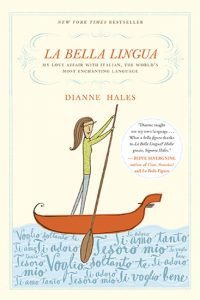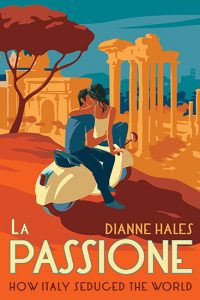
A guest post by Andrea Gelfoso
Eating Italian food in Italy made me cry. The first time I had pizza during our year in Modena, tears ran onto the perfectly crisp crust. I’m a vegetarian, so vegetables rule. Pizza offered toppings from all over the produce aisle: artichoke, eggplant, peppers, zucchini, onions, spinach. And a variety of cheeses: gorgonzola, parmigiana, different types of mozzarella (fior di latte is made from cow’s milk, fior di latte di bufala from water buffalo milk), provolone. Pizza dough cooks very quickly, so if you use fresh vegetables, the toppings are crunchy and can be bitter. In Italy the veggies are marinated in olive oil, gently roasted, then seared into melted cheese.
Pizza was a revelation, but there was so much else to eat, even for a vegetarian. When I first tried tortelloni in butter and basil, I understood why butter should be served fresh. Fresh melted butter is a handful of sunshine splashed across the plate. Ligurian trofie with plump green beans and pesto is comfort food made magnificent.
My relationship with Italy was sadly dysfunctional because of the food. When postal employees refused to sell me stamps because They. Must. Weigh. Each. Letter. Of. Each. Word. before I sealed the envelope, I was enraged. But all it took was a cup of cappuccino and I loved them again. A cloud of milk sprinkled with sugar and swirled into perfectly roasted coffee made every cup a short but memorable visit to heaven. Why be mad?
Italian produce, even the hack produce at the supermarket, was fresher than the crates of Styrofoam sold at Costco. Slice into an Italian carrot, and the blade is slick with juice. Garlic cloves bead with moisture when cut. Mushrooms are packed just as they’re harvested: with balls of soil clinging to the rounded bottoms. The fruit is heavy and sweet. Blood oranges, iridescent with intense flavor, are an explosion of fireworks to satisfy all of your senses. Grapes have both a tang and the mellowness of good rain and steady sunshine.
I probably ate grapes from vines I could see from the train. Everything was sold in season, so in the grocery store, there were no Brussels sprouts in the spring, there was no broccoli until the fall. Growers don’t use wax or preservatives, so vegetables spoiled quickly. Peppers lasted four days at most, green beans dried out and broccoli yellowed in three days. So you stopped at the market every day, cooked everything immediately, and savored every bite. And the cheese—oh my, the cheese! American provolone tastes like a pencil eraser, but Italian provolone is nutty, mellow. Provolone piccante (sharp, not spicy) was a transformative experience. Fresh grated parmesan added shards of brilliance to anything it fell on.
In Italy, every dish awakens your senses. Salad starts with fresh greens with all of the aroma of newly cut grass. I added sliced carrot, fresh tomatoes, olive oil. And balsamic vinegar, which is made in Modena in a loving, patient process that takes a minimum of 12 to 25 years. American balsamic vinegar is painfully acidic, but aging makes balsamic sweet. A great bottle of old Modena aceto costs 180 euros, and you can eat it with a spoon. But after only 12 summers in a wooden cask, traditional aceto pools on the lettuce and flirts with the olive oil; every bite tells you why those two have stayed together all these years.
We never had leftovers, so my favorite lunch was fresh pugliese bread, provolone piccante, salad greens, tomatoes, and sweet balsamic vinegar. With Classica chips. Most evenings I went into the tiny, blue-tiled kitchen, took up a sharp knife and sliced and sautéed and stirred, while listening to Pavarotti. I chopped and stirred and sautéed until my arm stopped working, and only then had I made enough to tide my son over until dessert. . I chopped, and I stirred, and Pavarotti and I looked out my little window onto the roofs of Modena, and I didn’t feel like writing about food, I was too busy living it.
 Andrea Susan Valentine Gelfuso Goetz is an environmental attorney who adores Italy and all things Italian. A year in Italy with her husband and two kids, while living in an apartment that was like camping, with tile, and in a city that was like God’s attic, made her appreciate Italian culture, art and heart-stoppingly gorgeous Italians. My Modena: A Year of Fear, Laughter, and Exhilaration in Italy details the delightful confusion of living in a town that made every task hilariously frustrating, but every walk a journey into Italy’s fascinating past — and thrilling present.
Andrea Susan Valentine Gelfuso Goetz is an environmental attorney who adores Italy and all things Italian. A year in Italy with her husband and two kids, while living in an apartment that was like camping, with tile, and in a city that was like God’s attic, made her appreciate Italian culture, art and heart-stoppingly gorgeous Italians. My Modena: A Year of Fear, Laughter, and Exhilaration in Italy details the delightful confusion of living in a town that made every task hilariously frustrating, but every walk a journey into Italy’s fascinating past — and thrilling present.
Dianne Hales is the author of LA BELLA LINGUA: My Love Affair with Italian, the World’s Most Enchanting Language; LA PASSIONE: How Italy Seduced the World; MONA LISA: A Life Discovered; and “A” Is for Amore, which you can download for free at diannehales.com.







